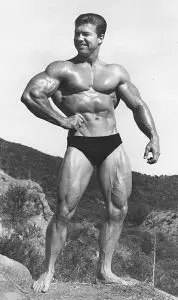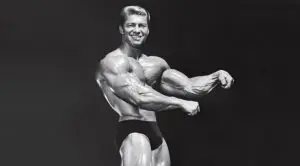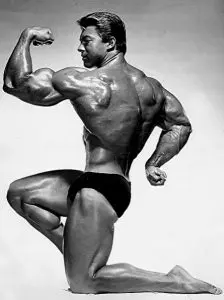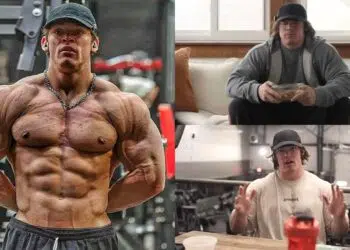Few bodybuilding champions captured the imagination and support of millions in the same way as Larry Scott. Type Larry Scott into google and you’ll find a litany of information on Scott’s training techniques, diet and also his close relationship to Vince Gironda. Dig a little deeper, however, and you’ll come across a story of overcoming and perseverance. Larry, the first Mr. Olympia champion, was not a man blessed with genetics. He knew this, and so did the rest of the bodybuilding community. Writing on Scott in 1981, Joe Weider, the ‘Trainer of Champions’ claimed that Larry ‘had a narrower-than-normal shoulder structure and fairly wide hips, but by dint of total dedication to bodybuilding, unswerving perseverance, and faithful adherence’ to his craft, he managed to transform his body. (1) Now for reasons unclear to me, the definitive Scott biography has yet to be written. Seeking to address this problem, at least partially, today’s post gives a short biography of Larry Scott and highlights his important nutrition and training contributions to the Iron Game and how you can implement the methods and moves which built a two time Mr. Olympia.
An (Unlikely) Star is Born
Speaking to Irving Johnson in Ironman magazine in the early 1960s, Scott presented his rather humble beginnings in weight lifting. Born in Blackfoot, Idaho in 1938, Scott’s early years were defined largely by his slight frame. (2) At 17 years old, Larry weighed just 120 lbs. It was for this reason that Alan Palmieri would later write of Scott that ‘he was thin, narrow-shouldered and short in stature. I guess you might say by all indications that he was a genetic shrimp.’(3) Shrimp or not, Scott displayed an early, and enduring interest in physical activity. Being too small for football and too short for basketball, Scott instead joined his local high school gymnastics team. Still, in high school, Larry was even invited to compete with the Idaho State College Gymnastic Team.
Turning to all things iron, Larry first tried his hand at weightlifting aged seventeen but struggled to make any real progress. (4) Returning to his interview with Johnson, Scott admitted that he trained diligently for three months with little no results Eventually through hard work, and a considerable amount of eating, Scott increased his bodyweight to 171 lbs. and by 1959 he took first at the Mr. Idaho contest. (5) Buoyed by his success he moved on to California where a series of 3rd place finishes in local bodybuilding shows and a plateau in his weight gaining pushed Scott to try new approaches.
It was at this point that Scott joined forces with Irving Johnson, the man who interviewed him for Ironman in 1964. Johnson, by that time, was better known by his commercial name, Rheo H. Blair. (6) Specifically, Johnson was famed for his innovative and much-coveted protein powders and supplements. At a time when bodybuilding supplements were still in their infancy, Blair’s products were very much ahead of the curve. When Scott met Blair he was still struggling to increase his weight. Under Blair’s guidance, Scott spent two months consuming vast quantities of Blair’s protein powder and, in the end, gained 9 pounds of muscle. (7) It was then that Scott won the Mr. California contest. The Mr. California was the first of many competitions Scott won over the next ten years.
View this post on InstagramGet Fitter, FasterLevel Up Your Fitness: Join our 💪 strong community in Fitness Volt Newsletter. Get daily inspiration, expert-backed workouts, nutrition tips, the latest in strength sports, and the support you need to reach your goals. Subscribe for free!
It was in the early 1960s that Scott joined forces with Vince Gironda, the ‘Iron Guru’. At that time, Vince was one of bodybuilding’s most sought after coaches. Under Gironda’s guidance, Scott transformed his physique. Scott had won competitions prior to meeting Gironda, but this did not mean the ‘Iron Guru’ was impressed. (8) After Scott’s victory in the 1960 Mr. California, word got back to Scott that Gironda felt he hadn’t deserved to win. For Gironda, Scott wasn’t yet ready ‘physiologically.’ Curious to know more, Scott entered a longtime friendship with Gironda. With Gironda guiding his training and Blair handling his nutrition, Scott began to capture the bodybuilding community’s imagination.
From 1961 to 1964, Scott won a series of highly coveted bodybuilding contests such as the Mr. Pacific Coast (1961), the Mr. America title (1962), and the Mr. Universe (1964). By the time of his Mr. Universe competition, Scott’s legend had already been born. (9) Despite his poor genetics, Scott boasted some of the finest deltoid and tricep muscles people had ever seen. In fact, Scott is still best remembered for his arms and shoulders despite his overall muscular symmetry. Nevertheless, people wanted to emulate Scott’s arms and it was for this reason that Scott’s later book Loaded Guns proved so successful. (10) Returning to bodybuilding contests, Scott’s timing could not have been better.
As explained by Dr. John Fair, the mid-1960s witnessed a series of new bodybuilding competitions emerge. From the late 1930s to early 1960s, only a handful of major bodybuilding competitions existed. Of these, the Mr. America contest was the most important. From the late 1950s onward, a series of new events and contests began to emerge.(11) The most enduring of these new contests was, of course, the Mr. Olympia competition, created by Ben and Joe Weider in 1965. Having won Mr. America, and Mr. Universe, Mr. Olympia was the last mountain Scott had to climb. Thus in 1965, Scott took to the Mr. Olympia stage. The result was, as recounted by Joe Weider, electrifying.
This year, men like Harold Poole, Earl Maynard and Larry Scott competed. As each man stepped into the light he received a tremendous ovation. But even before Larry Scott came out, the fans chimed: “We want Scott … we want Scott!”
As soon as he stepped out of the wings, the auditorium exploded with thunderous applause. It was deafening … a roar … and flashbulbs flooded the stage with so much light that it seemed as if the sun had rose.
The roar became a deafening hum and the floor actually trembled from the pounding of feet. The crowd went wild – mad with excitement and enthusiasm … and it was clear that Scott was the winner – that he had been unanimously declared the world’s greatest bodybuilder … the first of the great bodybuilders – the first MR. OLYMPIA.(12)
Scott went on to successfully defend his Mr. Olympia crown in 1966. With nothing else to prove, Scott retired from the sport of bodybuilding to focus on his family and business interests. It was a decision that shocked the sport’s fans. Now free from the strain of competing, Scott spent the next two decades publishing bodybuilding books, writing for bodybuilding magazines and training others for bodybuilding contests. (13) He briefly returned to bodybuilding in 1979 when he entered two contests in Canada but, by then, his once legendary physique paled in comparison to a new generation of competitors. When Scott passed away in 2014, fans and fellow competitors mourned the loss of bodybuilding’s first Mr. Olympia. Arnold Schwarzenegger to your average gym-goer, everyone acknowledged a debt to Larry Scott for all he had done. (14) Why did Arnold and others have such respect for Scott? Aside from his impressive trophy collection, Larry helped to revolutionize the sport of bodybuilding in more ways than one.
Changing Nutrition Patterns
In the first instance, Larry’s transformation from weak and skinny to eventual Olympia champion helped mark a sea change in bodybuilding nutrition. As retold in John Fair and Daniel Hall’s wonderful article on protein powder, weight lifters and bodybuilders during the 1940s and 1950s were relatively simplistic in their dietary habits. The great doyen of American weightlifting, Bob Hoffman would, for many years, claim that all gym-goers needed to do was eat wholesome foods and plenty of them. (15) The idea that any sort of nutritional supplement was necessary was rarely considered. This was comically seen in a meeting between Bob Hoffman and Paul Bragg during the 1940s. For those unaware, Braggs was one of America’s most influential nutritionists of the early twentieth century. His writings, books, and lectures helped spark a deep and enduring interest in healthy foods and alternative lifestyles. (16)
Level Up Your Fitness: Join our 💪 strong community in Fitness Volt Newsletter. Get daily inspiration, expert-backed workouts, nutrition tips, the latest in strength sports, and the support you need to reach your goals. Subscribe for free!
Braggs, himself, was deeply aware of the value of nutritional supplements and it was for this reason he approached Bob Hoffman. At that time, Hoffman was one of America’s most successful fitness entrepreneurs, selling vast amounts of barbells across the United States. He did not, however, sell supplements. Braggs set out to change this when he approached Hoffman. Hoffman had a ready market of customers, many of whom relied heavily on his products and writings for guidance. Braggs was excited about the prospect of working together on a range of supplements but was quickly left sorely disappointed when it became clear that Hoffman did not share his interest in. Hoffman’s only idea for a nutritional supplement was a protein-enriched bread. It was a far cry from the protein powders and multivitamins of the current age. This meeting came in the 1940s but little had changed two decades later. (17)
Some protein powder sellers had emerged in the 1960s, including Rheo H. Blair and a now enthusiastic Hoffman, but the appetite for protein powders for regular trainees was still relatively small. Scott’s own body transformation changed this state of affairs. Working under the guidance of Rheo H. Blair, Scott increased his body weight dramatically. Scott’s weight gain was impressive but what really caught people’s attention was that Scott increased his body weight consuming a large amount of Blair’s protein powder. In later reports, Scott claimed
I was using from 11/2 to 2 cups of Johnson’s Protein (Rheo H. Blair’s Protein) per day. I would mix it with cream and milk. I used about 2/3 of a quart of cream a day in mixing this along with the milk to make it the desired consistency. I took this protein-cream mix three times per day. I would eat 6 to 8 times per day. I would have breakfast, then a snack at 10 A. M. and then lunch at noon, then another snack at 2:30 P.M., then dinner plus the Protein-Cream drink. My evening meal is eaten after I work out…(18)
Scott began to feature in Blair’s advertising, preaching the clear message that protein powder helped build his competition physique. In later advertisements, titled ‘Open Letter to Bodybuilders from Larry Scott’, Scott claimed that ‘the need for Proteins is well established. Instead of 3 large meals, I eat 5 or 6 smaller meals a day. The feedings always include animal proteins.’(19). The bulk of Scott’s smaller meals were Blair’s protein which he claimed to have used for five years without fail. Alan Palmieri has claimed, with good reason, that Scott’s endorsement of Blair’s protein helped kick the then-burgeoning supplement industry into overdrive.(20) By the time Blair retired from bodybuilding in 1967, countless bodybuilders, both amateur and competitive, were using protein powders to build their bodies. Scott was among the first major bodybuilders to publicly do so and helped inspire a later generation.
More than this, however, Scott’s story of a weakling to Mr. Olympia helped inspire regular gym-goers to build their physiques. He was one of the first noted ‘hard gainers’ to make it big in bodybuilding. Later trainees were told that because Scott overcame his own poor genetics, then so could they. That Scott did this through the use of protein powders meant that many followed him. The hardgainer’s reliance on protein powders began, in part, with Scott.
An Innovator in the Gym
As is perhaps becoming clear, Scott was fortunate in that his work ethic and enthusiasm met with some truly great minds. For nutrition, Scott self-experimented with Blair’s protein powders and his ideas on health. For training, Scott had the good fortune to join forces with Vince Gironda. Gironda was outspoken, quick-tempered and, importantly, successful in producing champions. The two were a bodybuilding match made in heaven. According to Scott,
Vince had a lot of knowledge and professionally we were close and I would go to him all the time when I had any questions about training and something I was trying to figure out. Vince was always really good about giving me ideas. He was very knowledgeable about physiques in that he wouldn’t give you an idea and just say, “you got to do this,” he would say, “try this.” Then I would take it and try it and let him know whether or not it worked.(21)
With Vince’s precepts in mind, the two helped create several highly effective training exercises and machines. The most influential of which was the Preacher Curl. Originally created by Easton Brothers in their Hollywood Gym, the Preacher Curl bench was then an unknown piece of equipment. At Gironda’s gym in Venice Beach, California, Scott was given free reign to train his biceps on the bench. When Larry Scott began winning competitions again, people began to take notice of his training methods. In particular, people became interested in the Preacher Curl. (22) Through Scott’s appearances in Joe Weider’s bodybuilding magazines, people began speaking about the ‘Scott Bench’, known to us now as the Preacher Curl. That the Preacher Curl was briefly known as the ‘Scott Bench’ caused some tension between Gironda and Scott but both were aware that Scott helped to popularise it for the broader masses. (23)
Scott’s arms were undoubtedly part of his star attraction. Aside from popularising the Scott/Preacher bench, Scott also used a series of weird and wonderful triceps exercises to build his Olympia winning arms. Many of these exercises, for reasons unbeknownst to me, are no longer used by gym-goers, such as the barbell triceps kickback. For a brief moment, however, Scott’s other unique triceps exercises, such as Scott’s twist on the traditional overhead triceps extension had everyone mimicking his movements. (24) Influenced by Vince Gironda’s own training methods, the Scott triceps extension is done on top of a bench placed roughly two feet in front of a cable station. As evidenced by the video below, the angle is quite different to a standard triceps extension and helps provide an entirely different way of hitting the triceps.
Scott’s desire to trial new exercises and variations undoubtedly contributed to his genius. This also extended to his deltoid training. The Scott palm out dumbbell press is similar to the Arnold Press in the sense that it was used exclusively by Scott to build his shoulder width and density in much the way Arnold did with his shoulder press a decade later. Fortunately, we actually have the remaining video of Scott demonstrating his shoulder exercise, which saves me providing a confusing description. Much like Scott’s Tricep extension variation, gym-goers, including our favorite golden age bodybuilders of the 1960s, mimicked Scott’s exercises. (25) More important than this however was Scott’s role in encouraging others to continue tweaking their exercises until they found what worked for them.
Remembering Scott Today
Today Scott is remembered as the first Mr. Olympia and, I would argue, little else. This does a disservice to a man who played a pioneering role in popularising protein supplements, a man who inspired thousands of hardgainers and an individual whose curious mind spawned dozens of new exercises. Scott is a man who retired from bodybuilding at the very top of his game but remained humble and willing to help those seeking to follow in his footsteps. Scott once said “motivate the mind, the body will follow”. His own tenacity in following his dreams was testament to his belief in this message.
References
- Weider, Joe. Bodybuilding, the Weider approach. Contemporary Books, 1981, 75.
- Johnson, Irving, ‘Larry Scott’, Ironman Magazine, 24, no. 2 (1965): 23-27.
- Palmieri, Alan, Larry Scott: The Legend. Self-Published, c. 2008, 2.
- Johnson, ‘Larry Scott’.
- Ibid.
- Hall, Daniel T., and John D. Fair. “The Pioneers of Protein.” Iron Game History 8, no. 3 (2004): 23-34.
- Johnson, ‘Larry Scott’.
- Palmieri, Larry Scott, 4-5.
- Roach, Randy. Muscle, smoke, and mirrors. Vol. 1. AuthorHouse, 2008, 357.
- Locks, Adam, and Niall Richardson. “Strategies of Enfreakment: Representations of Contemporary Bodybuilding.” In Critical Readings in Bodybuilding, pp. 191-208. Routledge, 2013.
- Fair, John D. Mr. America: The tragic history of a bodybuilding icon. University of Texas Press, 2015, 1-20.
- ‘Here Is The Great Contest Picture Story You’ve Been Waiting For’, Muscle Builder, 15, no 10 (1965), 68.
- His website still exists today. See LarryScott.com.
- Locks, and Richardson. “Strategies of Enfreakment.”
- Hall, and Fair. “The Pioneers of Protein.”
- Ibid.
- Ibid.
- Palmieri, Alan, Rheo H. Blair and Blair Protein. Self-Published, c. 2008, 2-5.
- Ibid.
- Palmieri, Larry Scott, 4-5.
- Ibid.
- Ibid.
- Ibid.
- Weider, Bodybuilding, the Weider approach, 75.











